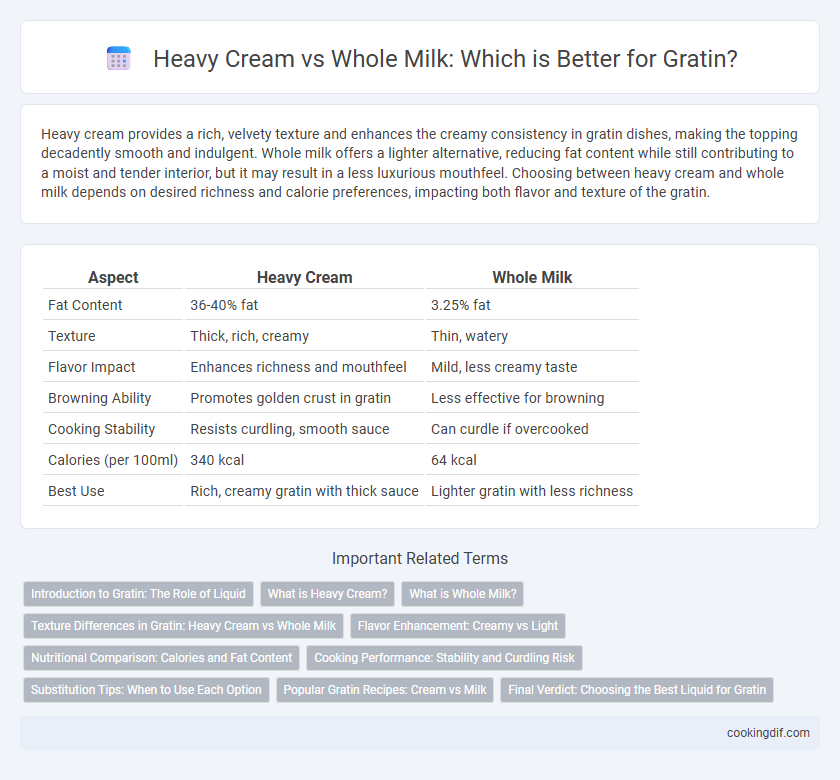Heavy cream provides a rich, velvety texture and enhances the creamy consistency in gratin dishes, making the topping decadently smooth and indulgent. Whole milk offers a lighter alternative, reducing fat content while still contributing to a moist and tender interior, but it may result in a less luxurious mouthfeel. Choosing between heavy cream and whole milk depends on desired richness and calorie preferences, impacting both flavor and texture of the gratin.
Table of Comparison
| Aspect | Heavy Cream | Whole Milk |
|---|---|---|
| Fat Content | 36-40% fat | 3.25% fat |
| Texture | Thick, rich, creamy | Thin, watery |
| Flavor Impact | Enhances richness and mouthfeel | Mild, less creamy taste |
| Browning Ability | Promotes golden crust in gratin | Less effective for browning |
| Cooking Stability | Resists curdling, smooth sauce | Can curdle if overcooked |
| Calories (per 100ml) | 340 kcal | 64 kcal |
| Best Use | Rich, creamy gratin with thick sauce | Lighter gratin with less richness |
Introduction to Gratin: The Role of Liquid
Heavy cream provides a rich, velvety texture and higher fat content essential for achieving the classic golden crust and creamy interior in gratin dishes. Whole milk offers a lighter alternative with less fat, resulting in a more delicate consistency but potentially less browning and depth of flavor. Selecting between heavy cream and whole milk directly impacts the gratin's richness, thickness, and overall mouthfeel.
What is Heavy Cream?
Heavy cream, also known as heavy whipping cream, contains at least 36% milk fat, offering a rich, velvety texture essential for classic gratins. Its high fat content enhances browning and creates a luxurious, creamy consistency that whole milk, with about 3.25% fat, cannot achieve. This makes heavy cream the preferred liquid for gratins, ensuring optimal flavor and a golden, bubbly finish.
What is Whole Milk?
Whole milk is a dairy product containing about 3.25% milk fat, offering a creamy texture with moderate richness, making it a versatile liquid base for gratins. It provides enough moisture without overpowering the dish's flavor, allowing the flavors of cheese, vegetables, or proteins to remain prominent. Unlike heavy cream, whole milk creates a lighter, less dense gratin, appealing to those seeking a balance between creaminess and caloric content.
Texture Differences in Gratin: Heavy Cream vs Whole Milk
Heavy cream creates a richer, silkier texture in gratin due to its high fat content, resulting in a velvety and luxurious mouthfeel. Whole milk produces a lighter, more delicate consistency, which may yield a less creamy but slightly firmer gratin. The choice between heavy cream and whole milk impacts the gratin's overall smoothness and richness, with cream providing superior moisture retention and a more decadent finish.
Flavor Enhancement: Creamy vs Light
Heavy cream enriches gratin with a rich, velvety texture and intense buttery flavor, enhancing the dish's savory depth and creating a luxurious mouthfeel. Whole milk offers a lighter, more subtle creaminess that allows the natural flavors of cheese and vegetables to shine without overpowering them. Choosing heavy cream elevates indulgence and complexity, while whole milk provides a delicate balance suitable for lighter gratin recipes.
Nutritional Comparison: Calories and Fat Content
Heavy cream contains approximately 345 calories and 37 grams of fat per 100 ml, offering a rich and creamy texture ideal for gratin dishes. Whole milk provides around 61 calories and 3.5 grams of fat per 100 ml, resulting in a lighter consistency with significantly lower calorie and fat content. Choosing between heavy cream and whole milk influences not only the caloric density but also the mouthfeel and richness of the gratin.
Cooking Performance: Stability and Curdling Risk
Heavy cream offers superior cooking performance in gratins due to its higher fat content, providing greater stability and reducing the risk of curdling during baking. Whole milk contains less fat, making it more prone to separating and curdling under high heat. The richness of heavy cream ensures a smooth, creamy texture, enhancing the gratin's overall consistency and flavor.
Substitution Tips: When to Use Each Option
Heavy cream is ideal for gratins requiring a rich, velvety texture and deep flavor, contributing to a golden, creamy crust when baked. Whole milk serves as a lighter alternative, suitable when a less dense sauce is desired or for calorie-conscious dishes, though it may result in a thinner consistency. To substitute, use whole milk with added butter (approximately 1 tablespoon per cup) to mimic cream's fat content, or dilute heavy cream with milk for a balance between richness and lightness.
Popular Gratin Recipes: Cream vs Milk
Heavy cream delivers a rich, velvety texture and intense flavor to popular gratin recipes, creating a luscious, golden crust that enhances the dish's indulgence. Whole milk offers a lighter, smoother consistency with fewer calories, making it ideal for those seeking a creamy gratin without overwhelming richness. Many classic recipes favor heavy cream for its superior thickness and caramelization, while whole milk provides versatility and a subtle dairy base.
Final Verdict: Choosing the Best Liquid for Gratin
Heavy cream delivers a rich, velvety texture and intensified flavor that elevates gratin dishes, creating a luxurious mouthfeel and golden, bubbly crust. Whole milk offers a lighter alternative with a creamier nuance but less thickness, resulting in a subtler, more delicate gratin. For a traditional, indulgent gratin, heavy cream remains the top choice, while whole milk suits those seeking a lighter yet creamy finish.
Heavy cream vs Whole milk for liquid Infographic

 cookingdif.com
cookingdif.com